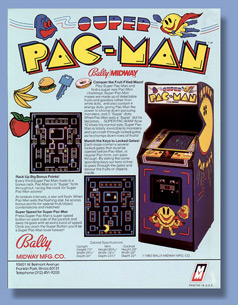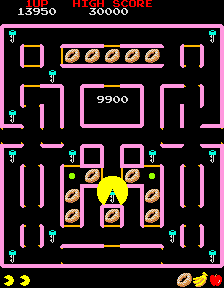 |
|||||||||||
![]()
 Bally/Midway 1982 (KLOV entry)
Bally/Midway 1982 (KLOV entry)
Reviewed by Nathan Strum
Most people recall Ms. Pac-Man as the first sequel to Pac-Man. But it wasn't originally intended to happen that way.
When Pac-Man became a huge hit, Namco began working on its sequel - Super Pac-Man. But it was taking them too long. Bally/Midway (who licensed Pac-Man for the U.S. market) was getting impatient - they wanted a sequel while Pac-Man was still a hot property.
Fortunately, the solution came along from a company called General Computer. General Computer had developed an enhancement board for Pac-Man called Crazy Otto, and had approached Bally/Midway for permission to market it. Impressed with their work, and desperate for a sequel, Bally/Midway had them rework Crazy Otto into what became Ms. Pac-Man.
The plan worked better than anyone could have imagined. Ms. Pac-Man drew unprecedented numbers of women into arcades and boosted revenue, but also offered enough challenge for the millions of die-hard Pac-Man players to keep coming back for more. In the end, Ms. Pac-Man outsold the original Pac-Man - 115,000 to 100,000 - and became one of the most respected games of the classic era. Namco was none-too-happy that Bally/Midway had released an unauthorized sequel, but they couldn't deny its success. Ms. Pac-Man was the perfect follow-up to Pac-Man - it took all of the gameplay elements that made Pac-Man a huge success, and improved on all of them.
With Super Pac-Man, on the other hand, Namco took all of the elements that had made Pac-Man a huge success, and threw them out the window.
Certainly, there were the die-hard Pac-fans who couldn't get enough Pac-Man games, and drove Super Pac-Man to some level of financial success. But from a gameplay standpoint, it failed to recapture any of the success of the original.
In Super Pac-Man, some basic familiar elements still exist - the intermissions, Pac-Man, the monsters, energizers, fruit, and a semblance of a maze. The similarities end there, however. The elegant simplicity of Pac-Man - clear the maze of dots while avoiding or eating monsters - becomes cluttered. Now, instead of a well-defined maze filled with dots, there's a simplified maze partially covered with fruit (or similar objects), keys, and not four, but six energizers. To clear a level, you have to eat all of the energizers and all of the fruit. It sounds like Pac-Man, but there's more to it than that.
Ghosts are on the run - thanks to the "classic" energizers. |
One of the key differences in the game is that now there are doors leading to various sections of the maze that have to be opened by eating the keys around the maze. As levels progress, the keys open different doors, so you can't rely on a certain key always opening up a certain door.
Another change is that when a bonus item appears, it shows up as a star with two chambers on either side. In each chamber, objects rapidly flash. If you happen to eat the star when both objects match, you get a huge bonus. Otherwise, you just get just a few hundred points. The problem here is that it's completely random - it's not tied in with the level you're currently playing, and it seems to be triggered when you eat a random piece of fruit. Luck has more to do with getting a bonus than skill does.
Two slices of pie will nab you a huge bonus. If you're lucky enough. |
The biggest single change is in addition to the four energizers that turn the monsters blue, there are two green ones that turn Pac-Man into Super Pac-Man. When this happens, Pac-Man becomes huge, and the monsters shrink, and Pac-Man passes right through them (unless they're blue, in which case he can eat them). While he's Super Pac-Man, he can also simply knock down any of the doors in the maze. You can also hit the Super Speed button during this time, and move at lightning-speed through the maze.
Super Pac-Man - busting up the place. |
There are also bonus mazes that pop up every few levels. No monsters - just you, the maze, and a bonus timer that counts down. The faster you clear the maze, the more bonus points you get. This is probably the biggest departure from Pac-Man, since there's almost nothing left of the original gameplay left in these levels. Without monsters, what is Pac-Man?
And the point of Pac-Man without monsters is...? |
By diverging from the original gameplay so much, Namco made a serious misstep. The whole challenge of having an intricate maze to completely clear of dots is gone. Super Pac-Man is more of a free-for all, than a game requiring careful strategy and concentration. Replacing the dots with fruit (or food, shoes, clovers, etc.) makes the game screen look cluttered, and more like a kid's game, than something aimed for a broader audience.
The bonus levels offer nothing in terms of a strategic challenge, and only contribute to the haphazard feel of the game. The fact that the maze never changes is another serious drawback - especially in light of the multiple mazes that came out in Ms. Pac-Man.
The biggest problem with Super Pac-Man though is that too much of an advantage is given to the player. With six energizers and super-speed, there's no reason to even give the monsters any consideration. Just grab a nearby energizer and blow through the maze until you reach the next one. Without needing to clear the entire maze surface of dots, there's not much ground that you're required to cover. Worse still, the monsters seem almost oblivious to your presence - in fact, they're downright stupid. The monsters become a non-issue, strategy is unnecessary, and the game rapidly becomes a bore.
Perhaps some combination of elements of Pac-Man and Super Pac-Man could have made for a solid game, but Namco really missed it here. In retrospect, it's probably a good thing Ms. Pac-Man was around, or the franchise might have been seriously damaged if Super Pac-Man had become the first sequel.
For what it's worth, at least Super Pac-Man wasn't the worst of the series. That distinction belongs to the Super-terrible Pac & Pal. Fortunately - I don't have to review that one.
Rating
![]()



